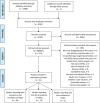Prevalence and factors associated with common mental disorders in young people living with HIV in sub-Saharan Africa: a systematic review
- PMID: 34164931
- PMCID: PMC8222842
- DOI: 10.1002/jia2.25705
Prevalence and factors associated with common mental disorders in young people living with HIV in sub-Saharan Africa: a systematic review
Abstract
Introduction: Common mental disorders (CMDs) particularly depression and anxiety, are highly comorbid with HIV also in young people living with HIV (YLWH). In sub-Saharan Africa (SSA) where most YLWH reside, there are limited summary data on CMDs among these youths, yet there are previous systematic reviews summarizing data on CMDs among adults living with HIV. We conducted a systematic literature review on the prevalence and correlates of CMDs among YLWH, aged 10 to 24 years, from SSA.
Methods: We searched African Index Medicus, African Journals Online and five other electronic databases (from database inception up to 31 December 2020) for relevant studies published in English. The key search terms applied were as follows: "Depression OR Anxiety", "Young people", "HIV infections" and "sub-Saharan Africa".
Results and discussion: Out of 3989 articles, 31 studies were included in the review. The prevalence of CMDs in YLWH widely varied ranging between 16.0% and 40.8% for major depression, 4.4% and 52.6% for depressive symptoms and 2.2% and 25.0% for anxiety symptoms. Anxiety disorder was estimated at 45.6%. Four of the five included studies with a comparison group of HIV-negative young people reported significantly higher prevalence estimates of depressive disorders among YLWH. Several sociodemographic, psychosocial and HIV-related correlates of CMDs were reported but most lacked consensus across studies. Nevertheless, female sex, older age, fewer schooling years, HIV-positive status, bullying, sexual abuse, HIV-related stigma, social support and poor antiretroviral therapy adherence were frequently reported (in ≥2 studies) as significant correlates of depressive symptoms among YLWH. Higher social support was the only frequent significant correlate of anxiety symptoms.
Conclusions: The burden of CMDs among YLWH from SSA is substantial and appears to be significantly higher when compared with HIV-negative peers, particularly for depressive disorders. However, more comparative research is needed. Importantly, screening for CMDs at the youth HIV-clinics should be prioritized especially for YLWH at high risk of CMDs, to facilitate early management or referral for treatment. Furthermore, youth-friendly psychological interventions addressing CMDs in YLWH should urgently be piloted in SSA, incorporating contextual components that may directly or indirectly reduce symptoms of CMDs among YLWH, such as social support.
Keywords: HIV infections; anxiety; correlates; depression; sub-Saharan Africa; young people.
© 2021 The Authors. Journal of the International AIDS Society published by John Wiley & Sons Ltd on behalf of International AIDS Society.
Figures
References
-
- UNFPA . The power of 1.8 Billion: adolescents, youth and the transformation of the future. united nations population fund. 2014. [cited 2020 Jul 3]. Available from: https://www.unfpa.org/sites/default/files/pub‐pdf/EN‐SWOP14‐Report_FINAL...
-
- WHO . Orientation Programme on Adolescent Health for Health‐care Providers. World Health Organization. 2006. [cited 2020 Jul 7]. Available from: https://www.who.int/maternal_child_adolescent/documents/pdfs/9241591269_...
-
- UNICEF . Adolescent HIV prevention. United Nations Children's Fund. 2019. [cited 2020 Jul 5]. Available from: https://data.unicef.org/topic/hivaids/adolescents‐young‐people/
-
- UNAIDS . Active involvement of young people is key to ending the AIDS epidemic by 2030. Joint United Nations Programme on HIV/AIDS. 2015. [cited 2020 Jul 3]. Available from: https://www.unaids.org/en/resources/presscentre/featurestories/2015/augu...
-
- Evangeli M. Mental health and substance use in HIV‐infected adolescents. Curr Opin HIV AIDS. 2018;13(3):204–11. - PubMed
Publication types
MeSH terms
Grants and funding
LinkOut - more resources
Full Text Sources
Medical
Research Materials


